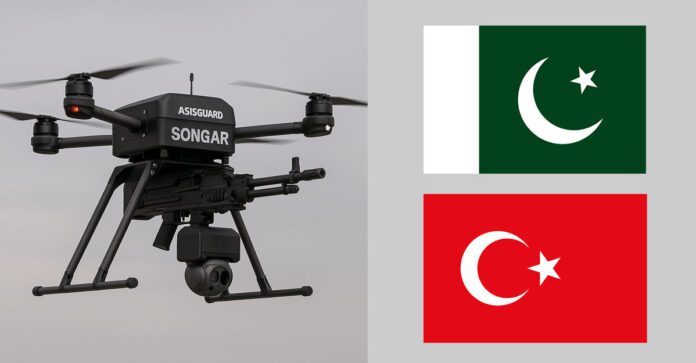In the latest escalation along the Line of Control and beyond, Pakistan has reportedly deployed Turkish-made Asisguard Songar Armed drones against India. These rotary-wing combat UAVs were observed providing precision fire support and surveillance to Pakistani forward units in contested zones across Jammu & Kashmir.
On May 9th, during a joint press conference held by the Ministry of External Affairs and the Armed Forces, Colonel Sofia Qureshi announced that the Indian Armed Forces successfully intercepted numerous drones originating from Pakistan, which were intended to target military installations across 36 locations, ranging from Leh to Sir Creek. She further clarified that the initial reports indicate that these drones are Turkish-made Asisguard armed drones.
This article delves into the origin, capabilities, and strategic relevance of the Songar drone system.
Asisguard Songar: Turkey’s Pioneering Armed Drone and Its Strategic Implications
In the evolving landscape of modern warfare, unmanned aerial vehicles (UAVs) have emerged as pivotal assets, reshaping combat strategies and operational dynamics. Among these, Turkey’s Asisguard Songar stands out as a testament to indigenous innovation, marking a significant milestone in the realm of armed drones.
Genesis and Development
Unveiled at the International Defence Industry Fair (IDEF) in Istanbul in 2019, the Songar drone was developed by Ankara-based defense firm Asisguard. It holds the distinction of being Turkey’s first domestically produced armed drone system. By 2020, following rigorous testing, Songar was officially inducted into the Turkish Armed Forces’ inventory .
Asisguard’s commitment to indigenous development is evident, with the Songar achieving an 83.42% domestic contribution rate, earning it the “Domestic Goods Certificate” at a high technology level .
Technical Specifications and Capabilities
The Songar is a quadrotor UAV designed for both day and night operations. Key features include:
Operational Range: Up to 10 km mission radius.
Altitude: Operational ceiling of 2,800 meters above mean sea level.
Payload: Equipped with a 5.56×45mm NATO standard machine gun, capable of carrying 200 rounds.
Stabilization: Features an automatic gun stabilizer (OASIS) and recoil damping system, ensuring firing accuracy.
Navigation: Integrated GPS and GLONASS systems for precise positioning.
Control: Operable in both autonomous and manual flight modes, with a ground control station providing real-time video and telemetry data .
The drone’s design emphasizes rapid deployment and ease of use, making it suitable for various military and security operations.
Variants and Enhancements
Asisguard has developed multiple variants of the Songar to cater to diverse operational needs:
Songar MG: Standard model with a machine gun.
Songar MG GL (T-40): Combines a machine gun with a grenade launcher.
Songar Togan: Integrated with SAGE Togan 81 mm mortar ammunition, offering a circular error probable (CEP) of 10 meters and a lethal radius of 35 meters .
Songar with RDS40-MGL: Equipped with a six-barrel rotary grenade launcher, capable of firing 40×46 mm and 40×53 mm caliber ammunition up to 800 meters .
These enhancements underscore Songar’s adaptability and its role in asymmetric warfare scenarios.
Strategic Implications
The introduction of the Asisguard Songar drone has significant implications for modern combat:
Force Multiplier: Its ability to provide close air support and conduct reconnaissance enhances the operational capabilities of ground forces.
Asymmetric Warfare: Songar’s precision and versatility make it a valuable asset in counter-insurgency and urban combat scenarios.
Export Potential: By 2021, Songar had been exported to two countries, indicating its growing international appeal .
The drone’s integration into armored vehicles further amplifies its utility, allowing for coordinated ground and aerial operations .
Source: Asisguard Website, Wikipedia and other media citations.


